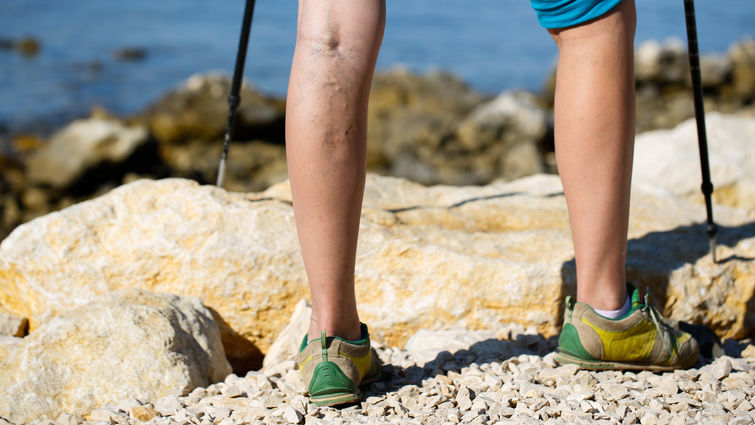
Over 25 million people, 1 in 3 people in the United States, live with varicose veins, according to the Society for Vascular Surgery. Though some people may not sense any symptoms, others with varicose veins can experience burning, throbbing, itching, cramping, heaviness, or other pain. In addition, the heat that summertime brings is known to irritate varicose veins and intensify symptoms.
Mohammad Reza Amini, MD, director of Peripheral Arterial and Venous Disease services at Loma Linda University International Heart Institute, offers a breakdown of summertime’s impacts on varicose veins and tips for alleviating symptom flare-ups.
One of the best first steps you can take to safeguard your health is to understand your varicose veins and how environmental factors such as heat may affect them, Amini says.
Veins are elastic blood vessels that bring blood back to the heart after traveling throughout different parts of the body. A series of valves behave like one-way gates in the veins, opening and closing to allow blood to travel from various body parts back to the heart. These vein valves thus enable blood to travel against gravity.
Over time, however, the veins’ valves can start to malfunction, enlarge, and cause gridlocks, Amini says. When this happens, blood begins to flow “backward.”
“When blood flows backward, it follows gravity down to the calf and ankle, creating pressure in superficial veins just underneath the skin,” Amini says. "The pressure creates what we call varicose veins."
The excessive strain on leg veins leads to the classic signs of varicose veins — bulging, twisted veins visible under the skin's surface. Excessive blood then pools in the veins, sometimes leading to swelling and other uncomfortable symptoms.
In the summertime, our circulatory system combats the effects of high temperatures by increasing the size of our veins, a process known as venodilation, for better blood flow to cool down the body. During venodilation, swollen varicose veins widen further, filling with additional blood and worsening the symptoms. When varicose veins fill with blood and bulge even more, Amini says the risk for related health complications also heightens.
Read: Varicose Veins: Cosmetic concern or health risk
Amini outlines several precautions and measures you can take if you seek to alleviate the uncomfortable symptoms of varicose veins.
Begin with basics
Amini advises addressing the fundamental pillars of health first and foremost; this means engaging in whole-body care through proper diet, exercise, and rest.
Obesity constitutes a significant risk factor for the development and worsening of varicose veins as pressure from extra body fat squeezes vein walls and damages the valves within. So, sticking to a heart-healthy diet — Mediterranean style and low carb, low-fat diets — can help achieve or maintain a healthy weight and benefit the entire circulatory system.
Read: Hot nutrition tips to keep your heart healthy in the summer
“If you can lose weight with these diets, that will help with your veins,” he says.
Any exercise you enjoy is a good option; in the summertime, Amini suggests water activities as a fun and healthy form of exercise. A bonus to swimming is its ability to help with joint problems, like arthritis, that some people with varicose veins may also suffer from, Amini says.
Read: How to protect your heart health during the summer
Lift your legs heart-level
When sitting or resting, Amini says propping your ankles up to meet the level of your heart will help with blood drainage in the legs, reduce swelling, and ease other symptoms. He recommends patients with varicose veins elevate their legs 3 or 4 times a day for about 15 minutes at a time.
If you need to sit for an extended time and don’t have the option to elevate your legs, like during a long flight, Amini says standing up every so often to flex and stretch your legs helps keep blood circulating.
Sport compression stockings
On the other hand, if you anticipate being on your feet for an extended time throughout the day, then Amini recommends wearing compressions stockings. These elastic stockings squeeze the veins and prevent blood and fluids from traveling down and pooling in the legs.
Shield from the sunshine
Staying cool in the shade will keep body temperature under control and protect from harmful UV radiation that some with varicose veins may be more sensitive to, Amini says. Many with varicose veins experience ankle swelling from blood pooling in the legs, which causes irritation, discoloration, redness, and sensitivity at the skin’s surface.
“The skin in the area where you are swelling loses a layer of protection over time, making it more sensitive to UV damage,” Amini says.
Any kind of UV protection is essential, he says: finding a shady hideout, wearing long, light, loose clothing, and regularly applying sunscreen.
Discuss with your doctor
If the swelling from your varicose veins is challenging to control, Amini recommends exploring treatment options with your doctor. Medications may help reduce swelling that irritates nerves and causes neuropathy, numbness, or leg aches. You may also consider the array of procedures offered to treat varicose veins. You and your provider can weigh options and engage in shared decision-making about the best way to proceed to ease your varicose vein symptoms.
At Loma Linda University International Heart Institute, physicians are committed to providing patients with compassionate, comprehensive, and personalized cardiovascular care. To learn more, please visit lluh.org/heart-vascular or call 1-800-468-5432 to make an appointment.
